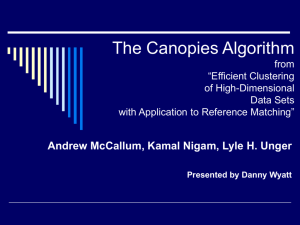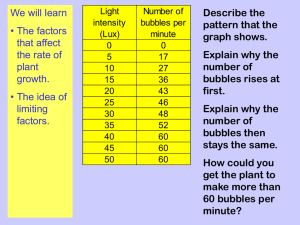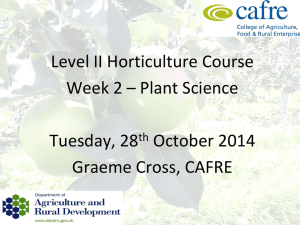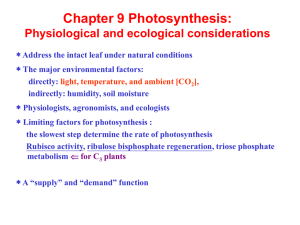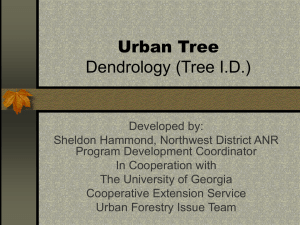PowerPoint-Präsentation
advertisement
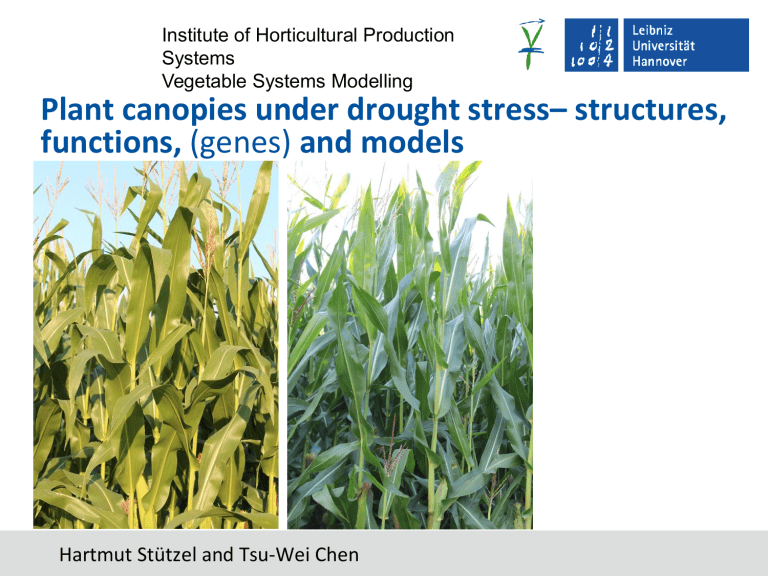
Institute of Horticultural Production Systems Vegetable Systems Modelling Plant canopies under drought stress– structures, functions, (genes) and models Hartmut Stützel and Tsu-Wei Chen Plant canopies: structural and functional properties Leaf area index Inclination of leaves Leaf angle distribution Leaf curvature Optical properties Light extinction coefficient Gap fraction Internode length Canopy photosynthesis CO2 transport (stomatal, mesophyll resistance) Biochemical conversion (Rubisco, light) Transpiration Light intensity, light quality and availability of water Canopies under stress 2 How are these functional and structural properties influenced by stress? How can we quantify stress effects on function and structure? Canopies under stress 3 35 6 25 20 15 10 Flag leaf length (cm) 5 Leaf angle (°) Specific leaf weight (mg cm-2) Flag leaf length, leaf angle 30 5 4 3 Flag leaf 2 Third leaf 1 0 0 0 100 200 300 Irrigation (mm) 0 100 200 300 Irrigation (mm) Morphological traits of wheat as related to water supply Canopies under stress after data fom Zhang et al. 2011 4 Simulated diurnal time course of net canopy photosynthesis for a maize crop having leaf area index (L) of 2, 4, or 8 and average leaf inclination from the horizontal of (a) 40°or (b) 80°. Simulation conducted for Day 180 of the year at Johnston, IA (41°40′ N lat) Canopies under stress Hammer et al. 2009 5 130% 70% Canopy light interception: 78% Light extinction coefficient: 0.60±0.02 Canopy light interception: 49% Light extinction coefficient 0.27±0.01 Simulated effects of increasing and decreasing leaf angle by 30 % on light extinction coefficient and Light interception of tomato canopies Canopies under stress Chen et al. 2014, J. exp. Bot., accepted 6 Response of net photosynthetic CO2 assimilation (PN) to intercellular CO2 concentration (ci) of barley plants grown at ambient (A) and elevated (B) [CO2] and subjected to well-watered conditions (circles) or 9 (squares), 13 (triangles) and 16 d (diamonds) of water stress. Canopies under stress Robredo et al. 2010 7 Generalized response of net photosynthesis (AN) and several parameters related to photosynthetic capacity to water stress when using daily maximum leaf stomatal conductance (gs) content as the reference for stress intensity Canopies under stress Flexas et al. 2012 8 Modelling canopy processes Big leaf models: treat the canopy as an extended leaf (or a small set of large leaves), map the properties of a whole canopy onto a single leaf (or a few leaves, Amthor, 1994) Sunlit-shade models: divide the (big leaf) canopy and leaf nitrogen between sunlit and shaded leaves (de Pury and Farquhar 1997) Multi-layer models: canopy is divided into layers, each with different light level, predicted by Beer’s law, and differentiation into sunlit and shade leaves (including a sunfleck penetration), a coupled scheme of leaf photosynthesis and stomatal conductance (Clark et al., 2011) → no precise prediction of the spatial and temporal heterogeneities of light inside a canopy Canopies under stress 9 Diurnal canopy CO2 uptake rate (Ac) of a rice canopy calculated with average photosynthetic photon flux density (PPFD) at different layers of a canopy (average light) compared with Ac calculated using the detailed PPFD of each individual facet in the canopy (detailed light). Canopies under stress Song et al. 2013 10 Spatially explicit models of canopies: Functionalstructural plant models (FSPM) Structure Environment Functions Canopies under stress Simulate plant growth and development based on individual organs Explicitly allow for feedbacks between plant structure and plant function Interactions between organs Canopies are constructed as assemblies of plants Static Dynamic 11 Dynamic cucumber architecture model Structure Environment Functions Canopies under stress 12 The virtual 2 m cucumber canopy with 18 plants, constructed using digitized data in GroIMP, in top view (A) and side view (B). Canopies under stress Chen et al. 2014; doi:10.1093/aob/mcu100 13 An example of dynamic functional-structural plant model (L-Peach, Allen, Prusinkiewicz and DeJong, 2005) 14 Functional-structural models: research questions Spatial integration of processes Effects of physiological limitations on canopy performance Effects of light direction (e.g. direct/diffuse) on growth Disentangling physiological from morphological effects Influence of canopy architecture modifications: row width, plant density etc. Assessment of plant traits: breeding, pruning …. Canopies under stress 15 Simulated leaf photosynthesis rate under 100 % direct light and 100 % diffuse light in a cucumber canopy Canopies under stress Chen et al. 2014; doi:10.1093/aob/mcu100 16 Analysis of limitations to productivity: Physiological limitations Photosynthesis CO2 diffusion Biochemical apparatus Light Structural limitations Leaf area Leaf area distribution Leaf exposition: leaf angle, azimuth angle Canopies under stress 17 Photosynthesis (mol CO2 m-2 s-1) 35 Reference photosynthesis rate 30 Biochemical limitation 25 Current photosynthesis rate 20 15 Light limitation Diffusional limitation 10 J = Jref 5 J = Jmax Current CO2 conc. 0 50 100 150 J 200 250 300 350 -1 Chloroplastic CO2 concentration (mol mol ) Calculation of photosynthetic limitations due to biochemical, light and diffusional factors Canopies under stress 18 Changes of (A) stomatal, (B) mesophyll, (C) diffusional (stomatal + mesophyll), (D) biochemical, (E) light and (F) total (diffusional + biochemical + light) limitations with leaf rank (counted from bottom to top) and light conditions above the canopy (79 % direct light and 21 % diffuse light) Canopies under stress Chen et al. 2014; doi:10.1093/aob/mcu100 19 Canopies under stress Chen et al. 2014; doi:10.1093/aob/mcu100 20 Simulated relationships between water potential in the root zone and photosynthetic limitations of a cucumber leaf on day 15 after leaf appearance. The environmental conditions were: ambient CO2 concentration = 380 ppm, water vapour deficit = 0.87 kPa, leaf absorbed light intensity = 800 µmol m-2s-1, and leaf temperature = 25°C. Canopies under stress 21 18 Photosynthesis rate ( mol CO2 plant-1 s-1) 16 Non-stress 14 12 10 8 6 4 2 0 0 200 400 600 Light interception ( mol photon plant-1 s-1) 18 Photosynthesis rate (mol CO2 plant-1 s-1) 16 Drought stress 14 12 10 8 Simulated effects of drought stress (soil water potential - 0.4 MPa) on photosynthesis rates at different positions in a cucumber canopy 6 4 2 0 0 200 400 600 Light interception (mol photon plant-1 s-1) Canopies under stress 22 Light use efficiency ( mol CO2 mol-1 photon) 0.05 Non-stress 0.04 0.03 0.02 0.01 0.00 0 200 400 600 Light interception ( mol photon plant-1 s-1) Light use efficiency ( mol CO2 mol-1 photon) 0.05 Drought stress 0.04 Simulated effects of drought stress (soil water potential - 0.4 MPa) on light use efficiencies at different positions in a cucumber canopy 0.03 0.02 0.01 0.00 0 200 400 600 Light interception ( mol photon plant-1 s-1) Canopies under stress 23 Influence of drought stress (water potential Ψs = -0.4 MPa in the root zone) on canopy photosynthesis and light use efficiency in different positions of the canopy upper Maximum Ac (µmol plant-1 s-1) Maximum LUEc (µmol CO2/µmol PAR) Ic for maximum LUEc (µmol plant-1 s-1) Non-stress Drought Non-stress Drought Non-stress Drought 5.9 5.1 0.046 0.041 49.0 44.9 Canopies under stress middleupper 4.3 3.7 0.040 0.035 55.7 50.9 Canopy part middlelower 3.9 3.4 0.033 0.029 59.3 60.6 lower 1.6 1.5 0.026 0.023 38.6 37.8 whole plant 15.6 13.7 0.038 0.033 231.0 214.6 24 What happens under salinity? Osmotic stress Ionic stress (ion accumulation) red. Toxic red. red. Biochemical capacity Non-architectural effects Organ size Photosynthesis Architectural effects Light use efficiency Transpiration Ion accumulation Stom. conduct. Light interception Canopies under stress 25 Shoot dry mass (% of control) 110 100 y = 100 -0.34x R2 = 0.91 90 80 y = 100 -0.49x R2 = 0.99 70 Low temperature High temperature 60 0 20 40 60 80 Salinity level (mM NaCl in nutrient solution) Effect of salinity on shoot dry mass on day 77 after the first leaf appearance under 22/18°C (low temperature) and 32/28°C (high temperature) day/night temperature conditions Canopies under stress 26 Relative light use efficiency at three salinity levels under low (LT, 22/18°C) and high (HT, 32/28°C) day/night temperature conditions Day 29-35 36-43 44-50 51-56 57-63 64-70 71-77 40 mM LT HT 1.17 1.07 1.10 1.06 1.05 1.02 1.07 1.02 0.97 0.93 1.05 1.05 0.93 0.96 Canopies under stress 60 mM LT HT 0.96 0.93 0.88 0.91 0.85 0.86 0.86 0.85 0.78 0.79 0.73 0.89 0.75 0.83 80 mM LT HT 0.80 0.81 0.69 0.78 0.68 0.73 0.66 0.72 0.64 0.67 0.66 0.75 0.61 0.71 27 110 Architectural effects on shoot dry mass (% of control) Shoot dry mass (% of control) 110 100 90 80 70 Low temperature High temperature 60 0 20 40 60 80 Salinity level (mM NaCl in nutrient solution) 100 90 80 70 60 30 40 50 60 70 80 90 Salinity level (mM NaCl in nutrient solution) Total and architectural effects of salinity on shoot dry mass on day 77 after the first leaf appearance under 22/18°C (low temperature) and 32/28°C (high temperature) day/night temperature conditions Canopies under stress 28 Conclusions A canopy is more than a big leaf Canopy structure has strong impact on productivity and resource use → optimization Systematic analysis of architectural effects on productivity and resource use is just at the beginning FSPM are models Canopies under stress 29 Thank you! Canopies under stress 30

